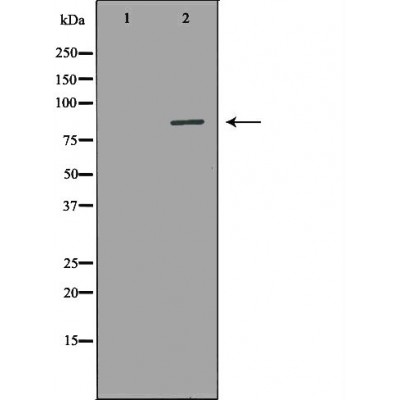AOC3 Antibody - #DF6745
| Product: | AOC3 Antibody |
| Catalog: | DF6745 |
| Description: | Rabbit polyclonal antibody to AOC3 |
| Application: | WB IHC |
| Reactivity: | Human, Mouse, Rat |
| Mol.Wt.: | 84kDa; 85kD(Calculated). |
| Uniprot: | Q16853 |
| RRID: | AB_2838707 |
Related Downloads
Protocols
Product Info
*The optimal dilutions should be determined by the end user. For optimal experimental results, antibody reuse is not recommended.
*Tips:
WB: For western blot detection of denatured protein samples. IHC: For immunohistochemical detection of paraffin sections (IHC-p) or frozen sections (IHC-f) of tissue samples. IF/ICC: For immunofluorescence detection of cell samples. ELISA(peptide): For ELISA detection of antigenic peptide.
Cite Format: Affinity Biosciences Cat# DF6745, RRID:AB_2838707.
Fold/Unfold
Amine oxidase, copper containing 3 (vascular adhesion protein 1); AOC3; AOC3_HUMAN; Copper amine oxidase; HPAO; Membrane copper amine oxidase; Membrane primary amine oxidase; Semicarbazide sensitive amine oxidase; Semicarbazide-sensitive amine oxidase; SSAO; VAP-1; Vascular adhesion protein 1; VP97;
Immunogens
A synthesized peptide derived from human AOC3, corresponding to a region within the internal amino acids.
Strongly expressed on the high endothelial venules of peripheral lymph nodes and on hepatic endothelia. Also highly expressed in appendix, lung and small intestine. Expressed also in adipose tissue, in bone marrow, colon, heart, kidney, ovary, pancreas, placenta, prostate, skeletal muscle, spleen and testis. Isoform 2 seems to be the predominant transcript in fetal kidneys, fetal cartilage and fetal tonsils. The highest relative expression of isoform 2 occurs in skeletal muscle, heart, pancreas, kidney, and lung.
- Q16853 AOC3_HUMAN:
- Protein BLAST With
- NCBI/
- ExPASy/
- Uniprot
MNQKTILVLLILAVITIFALVCVLLVGRGGDGGEPSQLPHCPSVSPSAQPWTHPGQSQLFADLSREELTAVMRFLTQRLGPGLVDAAQARPSDNCVFSVELQLPPKAAALAHLDRGSPPPAREALAIVFFGRQPQPNVSELVVGPLPHPSYMRDVTVERHGGPLPYHRRPVLFQEYLDIDQMIFNRELPQASGLLHHCCFYKHRGRNLVTMTTAPRGLQSGDRATWFGLYYNISGAGFFLHHVGLELLVNHKALDPARWTIQKVFYQGRYYDSLAQLEAQFEAGLVNVVLIPDNGTGGSWSLKSPVPPGPAPPLQFYPQGPRFSVQGSRVASSLWTFSFGLGAFSGPRIFDVRFQGERLVYEISLQEALAIYGGNSPAAMTTRYVDGGFGMGKYTTPLTRGVDCPYLATYVDWHFLLESQAPKTIRDAFCVFEQNQGLPLRRHHSDLYSHYFGGLAETVLVVRSMSTLLNYDYVWDTVFHPSGAIEIRFYATGYISSAFLFGATGKYGNQVSEHTLGTVHTHSAHFKVDLDVAGLENWVWAEDMVFVPMAVPWSPEHQLQRLQVTRKLLEMEEQAAFLVGSATPRYLYLASNHSNKWGHPRGYRIQMLSFAGEPLPQNSSMARGFSWERYQLAVTQRKEEEPSSSSVFNQNDPWAPTVDFSDFINNETIAGKDLVAWVTAGFLHIPHAEDIPNTVTVGNGVGFFLRPYNFFDEDPSFYSADSIYFRGDQDAGACEVNPLACLPQAAACAPDLPAFSHGGFSHN
Research Backgrounds
Cell adhesion protein that participates in lymphocyte extravasation and recirculation by mediating the binding of lymphocytes to peripheral lymph node vascular endothelial cells in an L-selectin-independent fashion. Has semicarbazide-sensitive (SSAO) monoamine oxidase activity. May play a role in adipogenesis.
Topaquinone (TPQ) is generated by copper-dependent autoxidation of a specific tyrosyl residue.
N- and O-glycosylated.
Cell membrane>Single-pass type II membrane protein.
Strongly expressed on the high endothelial venules of peripheral lymph nodes and on hepatic endothelia. Also highly expressed in appendix, lung and small intestine. Expressed also in adipose tissue, in bone marrow, colon, heart, kidney, ovary, pancreas, placenta, prostate, skeletal muscle, spleen and testis. Isoform 2 seems to be the predominant transcript in fetal kidneys, fetal cartilage and fetal tonsils. The highest relative expression of isoform 2 occurs in skeletal muscle, heart, pancreas, kidney, and lung.
Belongs to the copper/topaquinone oxidase family.
Research Fields
· Metabolism > Amino acid metabolism > Glycine, serine and threonine metabolism.
· Metabolism > Amino acid metabolism > Tyrosine metabolism.
· Metabolism > Amino acid metabolism > Phenylalanine metabolism.
· Metabolism > Metabolism of other amino acids > beta-Alanine metabolism.
· Metabolism > Global and overview maps > Metabolic pathways.
References
Restrictive clause
Affinity Biosciences tests all products strictly. Citations are provided as a resource for additional applications that have not been validated by Affinity Biosciences. Please choose the appropriate format for each application and consult Materials and Methods sections for additional details about the use of any product in these publications.
For Research Use Only.
Not for use in diagnostic or therapeutic procedures. Not for resale. Not for distribution without written consent. Affinity Biosciences will not be held responsible for patent infringement or other violations that may occur with the use of our products. Affinity Biosciences, Affinity Biosciences Logo and all other trademarks are the property of Affinity Biosciences LTD.

